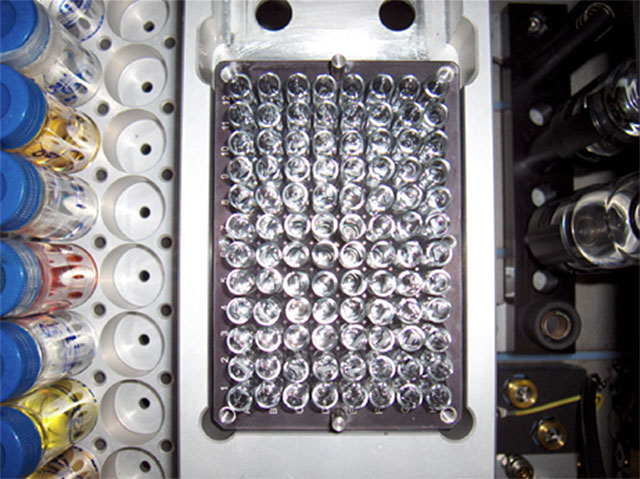Merck Catalysis Center
The Merck Center for Catalysis is a state-of-the-art facility at Princeton University whose goal is to leverage cutting-edge technologies to meet longstanding challenges in molecular construction for drug discovery.
The Center features a robotic system that allows for the rapid set-up, monitoring, and characterization of thousands of reactions. Opened in 2006 with funding from Merck, the facility today has more than 300 chiral organocatalysts available for new reaction screening. These novel catalysts are portioned into 96-well plates that are ready for use in reaction discovery and optimization.

Stock solutions and 96-well plate.
The instrument is equipped to weigh out powdered reagents or administer solutions as desired. Its encapsulation inside a glovebox enables researchers to easily run air and moisture sensitive reactions under an inert atmosphere. Reaction analysis is facilitated by GC-MS analysis, which identifies molecular weights of reaction products that may be further elucidated through advanced software that suggests possible chemical structures. Stir plates are also specially outfitted to allow for irradiation by light emitting diodes (LEDs) for the evaluation of photoredox reactions.
Generous support from Merck has made possible the discovery of myriad new reactions for the synthesis of valuable bioactive compounds. An area of recent interest has been in the burgeoning field of photoredox catalysis and its potential to streamline synthetic sequences. As a notable outgrowth, this endeavor has led to the invention of the Merck photoreactor, which has greatly facilitated the development of powerful new C–C and C–N bond forming technologies.
Highlighted publications:
“Silyl radical activation of alkyl halides in metallaphotoredox aatalysis: A unique pathway for cross-electrophile coupling,” Zhang, P.; Le, C. C.; MacMillan, D. W. C. J. Am. Chem. Soc. 2016, 138, 8084.
Link: https://pubmed.ncbi.nlm.nih.gov/27263662/
“Metallaphotoredox-catalyzed sp3–sp3 cross-coupling of carboxylic acids with alkyl halides,” Johnson, C. P.; Smith, R. T.; Allmendinger, S.; MacMillan, D. W. C. Nature 2016, 536, 322.
Link: https://pubmed.ncbi.nlm.nih.gov/27535536/
“Selective sp3 C–H alkylation via polarity match based cross-coupling,” Le, C.; Liang, Y.; Evans, R. W.; Li, X.; MacMillan, D. W. C. Nature 2017, 547, 79.
Link: https://pubmed.ncbi.nlm.nih.gov/28636596/
“A radical approach to the copper oxidative addition problem: Trifluoromethylation of bromoarenes,” Le, C.; Chen, T. Q.; Liang, T.; Zhang, P.; MacMillan, D. W. C. Science 2018, 360, 1010.
Link: https://pubmed.ncbi.nlm.nih.gov/29853683/
“Direct arylation of strong aliphatic C–H bonds,” Perry, I. B.; Brewer, T. F.; Sarver, P. J.; Schultz, D. M.; DiRocco, D. A.; MacMillan, D. W. C. Nature 2018, 560, 70.
Link: https://pubmed.ncbi.nlm.nih.gov/30068953/
“Metallaphotoredox-enabled deoxygenative arylation of alcohols,” Dong, Z.; D. W. C. MacMillan; Nature 2021, 598, 451.
Link: https://pubmed.ncbi.nlm.nih.gov/34464959/
A biomimetic SH2 cross-coupling mechanism for quaternary sp3-carbon formation,” Liu, W.; Lavagnino, M. N.; Gould, C. A.; Alcázar, J.; MacMillan, D. W. C. Science 2021, 374, 1258.
